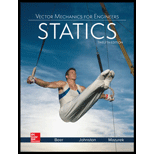
Concept explainers
9.41 through 9.44 Determine the moments of inertia

Fig. P9.43
Find the moment of inertia about x and y axis of the area with respect to centroid axes.
Answer to Problem 9.43P
The moment of inertia about x axis is
The moment of inertia about y axis is
Explanation of Solution
Calculation:
Sketch the cross section as shown in Figure 1.

Refer to Figure 1.
Find the area
Substitute
Find the area
Substitute
Find the total area (A) using the relation as follows:
Here,
Substitute
Refer to Figure 1.
Find the centroid
Find the centroid
Find the centroid
Find the centroid
Find the centroid
Substitute
Find the centroid
Substitute
Find the moment of inertia
Substitute
Find the moment of inertia
Substitute
Find the total moment of inertia
Substitute
Thus, the moment of inertia
Find the moment of inertia
Substitute
Find the moment of inertia
Substitute
Find the total moment of inertia
Substitute
Thus, the moment of inertia
Want to see more full solutions like this?
Chapter 9 Solutions
Vector Mechanics for Engineers: Statics
- Two L76 × 76 × 6.4-mm angles are welded to a C250 × 22.8 channel. Determine the moments of inertia of the combined section with respect to centroidal axes that are respectively parallel and perpendicular to the web of the channel.arrow_forwardIt is known that for a given area Iy = 48 x 106 mm4 and Ixy = -20 x 106 mm4, where the x and y axes are rectangular centroidal axes. If the axis corresponding to the maximum product of inertia is obtained by rotating the x axis 67.5° counterclockwise about C , use Mohr’s circle to determine (a) the moment of inertia Ix of the area, (b) the principal centroidal moments of inertia.arrow_forwardDetermine the moment of inertia (in4) Īx of the area shown with respect to the horizontal line that passes to the centroid of the composite area if b = 6.31 in, h = 0.76 in, L = 8.49 in, and W = 0.76 in. Round off only on the final answer expressed in 3 decimal places.arrow_forward
- Two L4 x 4 x 1/2-in angles are welded to a steel plate as shown. Determine the moments of inertia of the combined section with respect to centroidal axes respectively parallel and perpendicular to the plate.arrow_forwardDetermine the shaded area and its moment of inertia with respect to the centroidal axis parallel to AA, knowing that d1 = 25 mm and d2 = 10 mm and that its moments of inertia with respect to AA' and BB' are 2.2 × 106 mm4 and 4x 106 mm4, respectively.arrow_forwarddetermine the centroidal polar moment of inertia of a rectangle 100mm wide by 200 mm higharrow_forward
- Two L4 × 4 × 1/2-in. angles are welded to a steel plate as shown.Determine the moments of inertia of the combined section with respect to the centroidal axes that are respectively parallel and perpendicular to the plate.arrow_forwardTwo 20-mm steel plates are welded to a rolled S section as shown. Determine the moments of inertia and the radii of gyration of the combined section with respect to the centroidal x and y axes.arrow_forwardTwo 20-mm steel plates are welded to a rolled S section as shown.Determine the moments of inertia and the radii of gyration of the combined section with respect to the centroidal x and y axes.arrow_forward
- A farmer constructs a trough by welding a rectangular piece of 2-mm-thick sheet steel to half of a steel drum. Knowing that the density of steel is 7850 kg/m3 and that the thickness of the walls of the drum is 1.8 mm, determine the mass moment of inertia of the trough with respect to each of the coordinate axes. Neglect the mass of the welds.arrow_forwardDetermine the shaded area and its moment of inertia with respect to the centroidal axis parallel to AA′, knowing that its moments of inertia with respect to AA′ and BB′ are respectively 2.2 × 106 mm4 and 4 × 106 mm4, and that d1 = 25 mm and d2 = 10 mm.arrow_forwardDetermine the moment of inertia (mm4) Īx of the area shown with respect to the horizontal line that passes to the centroid of the composite area if a = 25 mm, b = 67 mm, and h = 117 mm. Round off only on the final answer expressed in whole number.arrow_forward
 Elements Of ElectromagneticsMechanical EngineeringISBN:9780190698614Author:Sadiku, Matthew N. O.Publisher:Oxford University Press
Elements Of ElectromagneticsMechanical EngineeringISBN:9780190698614Author:Sadiku, Matthew N. O.Publisher:Oxford University Press Mechanics of Materials (10th Edition)Mechanical EngineeringISBN:9780134319650Author:Russell C. HibbelerPublisher:PEARSON
Mechanics of Materials (10th Edition)Mechanical EngineeringISBN:9780134319650Author:Russell C. HibbelerPublisher:PEARSON Thermodynamics: An Engineering ApproachMechanical EngineeringISBN:9781259822674Author:Yunus A. Cengel Dr., Michael A. BolesPublisher:McGraw-Hill Education
Thermodynamics: An Engineering ApproachMechanical EngineeringISBN:9781259822674Author:Yunus A. Cengel Dr., Michael A. BolesPublisher:McGraw-Hill Education Control Systems EngineeringMechanical EngineeringISBN:9781118170519Author:Norman S. NisePublisher:WILEY
Control Systems EngineeringMechanical EngineeringISBN:9781118170519Author:Norman S. NisePublisher:WILEY Mechanics of Materials (MindTap Course List)Mechanical EngineeringISBN:9781337093347Author:Barry J. Goodno, James M. GerePublisher:Cengage Learning
Mechanics of Materials (MindTap Course List)Mechanical EngineeringISBN:9781337093347Author:Barry J. Goodno, James M. GerePublisher:Cengage Learning Engineering Mechanics: StaticsMechanical EngineeringISBN:9781118807330Author:James L. Meriam, L. G. Kraige, J. N. BoltonPublisher:WILEY
Engineering Mechanics: StaticsMechanical EngineeringISBN:9781118807330Author:James L. Meriam, L. G. Kraige, J. N. BoltonPublisher:WILEY





